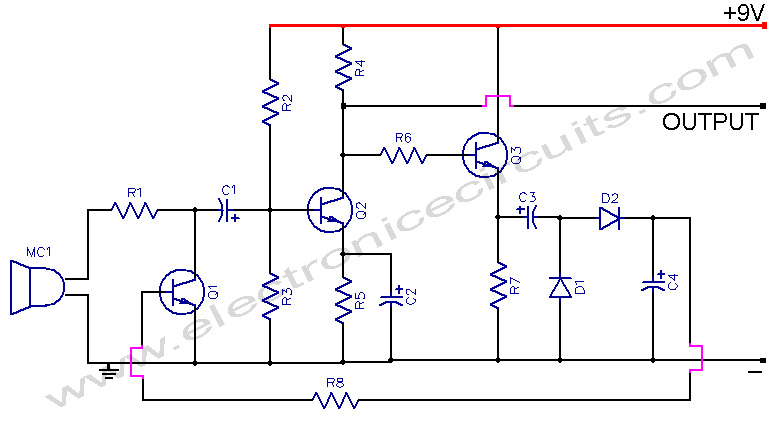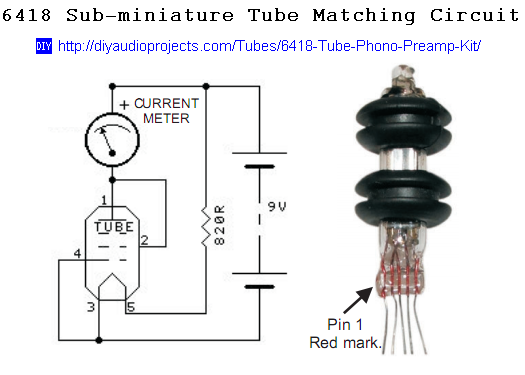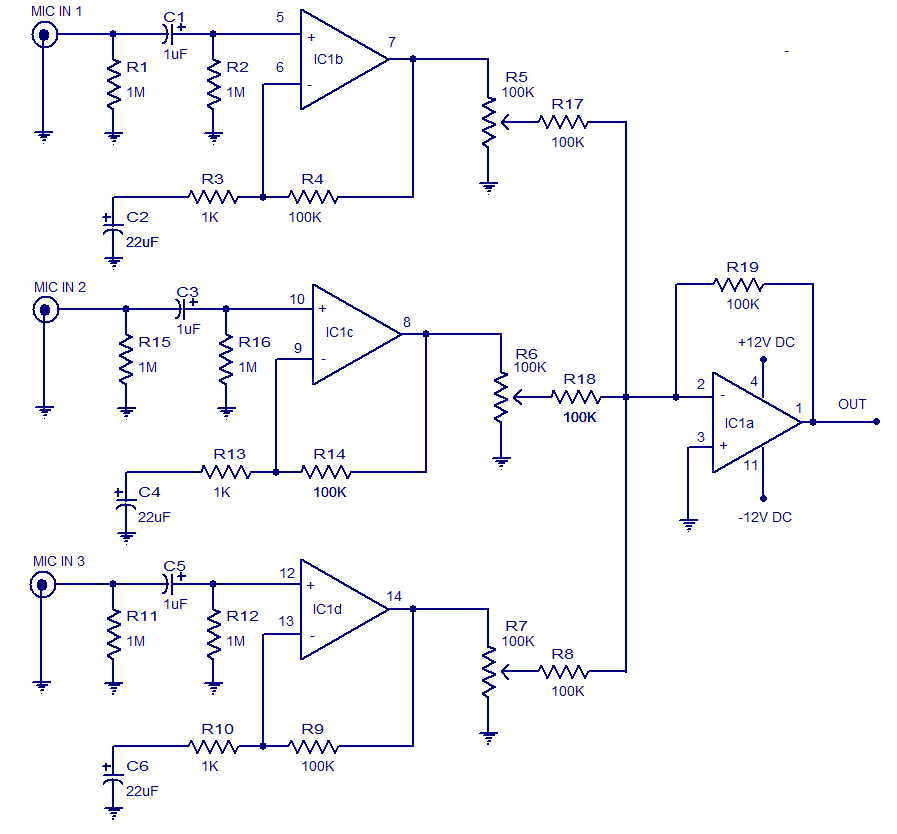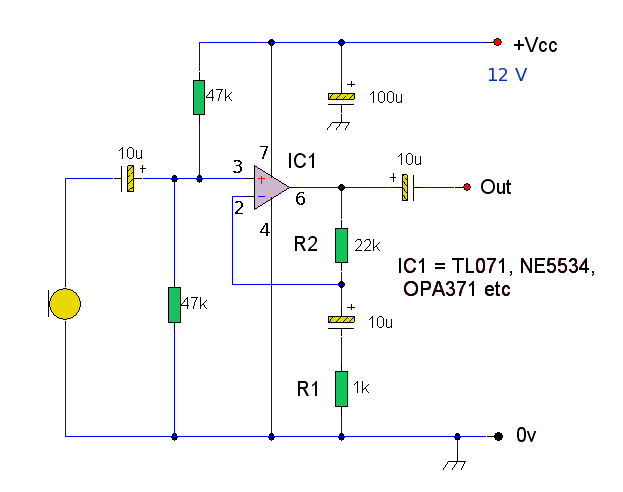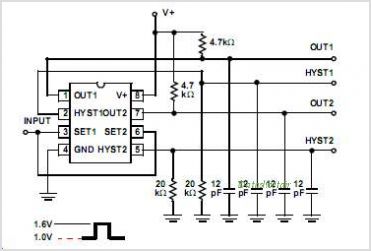
Tube Mic Pre-Amp
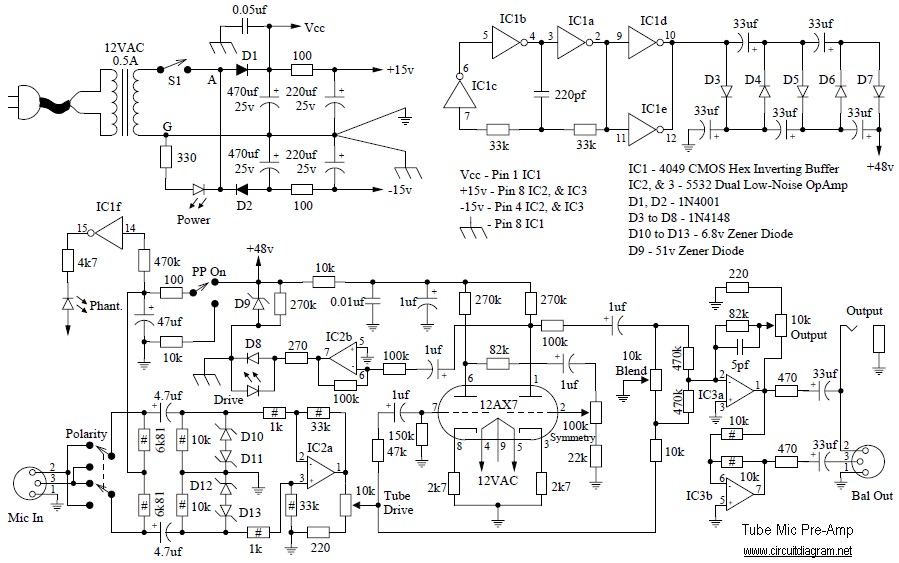
This is a simple audio microphone preamplifier circuit based on a single IC, the LM358. The circuit is straightforward, cost-effective, and easy to construct. The component parts list includes: R1, R3, R4 = 10K ohms, R2 = 1K ohm, R5 = 100K-1M potentiometer, C1 = 0.1uF, C2 = 4.7uF/16V, IC1 = LM358 dual op-amp (single supply), and a microphone = electret microphone. Additionally, there is a tube head vacuum tube preamp circuit designed by PAiA Electronics. The power connections are: Vcc - Pin 1 IC1 +12V, Pin 8 IC2, IC3, IC4 -12V, Pin 4 IC2, IC3, IC4 Ground - Pin 8 IC1. IC1 is a 4049 CMOS hex inverting buffer, while IC2, IC3, and IC4 are 5532 dual low-noise op-amps. The tube sound fuzz circuit is adapted from Craig Anderton's book "Electronic Projects for Musicians." This circuit employs a CD4049 hex inverter, which contains six inverting units, although only two are utilized in this configuration, with the others disabled by connecting their inputs to the positive voltage source. Additionally, a circuit diagram for a 20W power amplifier built using the EL34 tube is included. The EL34 is a well-known tube suitable for power amplifiers. The complete circuit encompasses both the tube amplifier and power supply circuit diagrams. For a stereo channel amplifier, a similar amplifier circuit should be constructed. Finally, a tube distortion pedal circuit designed by Ron Black is presented. Notes include: IC1: 747 dual op-amp (other ICs may be substituted, but the pinout will differ; the datasheet should be checked), IC2: LM340K-12V voltage regulator, all resistors rated at 1/2 W, and a full-wave bridge rectifier rated for 50 volts.
The audio microphone preamplifier circuit utilizing the LM358 is designed to amplify low-level audio signals from an electret microphone. The LM358 is a dual operational amplifier, which allows for flexibility in design. The resistors R1, R3, and R4, all rated at 10K ohms, are used in the feedback and input stages to set the gain of the amplifier, while R2 (1K ohm) helps to bias the microphone signal. The potentiometer R5, ranging from 100K to 1M ohms, provides adjustable gain control, enabling the user to tailor the output level to their requirements.
Capacitors C1 and C2 are included in the circuit to filter out noise and stabilize the power supply. C1 (0.1uF) acts as a decoupling capacitor, while C2 (4.7uF/16V) serves to couple the audio signal, ensuring that only the AC component of the microphone signal is passed to the amplifier without any DC offset.
The PAiA Electronics tube head vacuum tube preamp is a more complex circuit that employs the CD4049 hex inverter and 5532 dual low-noise op-amps to achieve a warmer, tube-like sound. The CD4049 is configured with only two of its six inverters being utilized, with the others disabled to prevent unwanted interference. This design allows for a unique tonal quality that is highly sought after in audio applications.
The 20W power amplifier circuit, which utilizes the EL34 tube, is designed to deliver quality audio performance. The EL34 is a popular choice among audiophiles for its rich sound characteristics and ability to handle high power levels. The accompanying power supply circuit ensures that the amplifier receives the necessary voltage and current for optimal performance.
Finally, the tube distortion pedal designed by Ron Black utilizes a 747 dual op-amp, which can be substituted with other op-amps, provided that the pin configuration is verified against the datasheet. The inclusion of a voltage regulator (LM340K-12V) ensures that the circuit operates within specified voltage levels, while the full-wave bridge rectifier converts AC to DC, providing stable power for the circuit operation. This comprehensive design caters to various audio applications, from simple microphone amplification to complex effects processing.Here the simple audio mic pre amplifier circuit based on single IC LM358. The circuit is very simple, inexpensive and easy to built. Component Parts List: R1, R3, R4 = 10K R2 = 1K R5 = 100K-1M Potensiometer C1 = 0. 1uF C2 = 4. 7uF/16V IC1 = LM358 dual op-amp single supply Mic = Electret Microphone. This is a simple and low cost Tube Head Vacuum Tub e pre-amp circuit designed bu PAiA electronics: Vcc - Pin 1 IC1 +12v - Pin 8 IC2, IC3, IC4 -12v - Pin 4 IC2, IC3, IC4 Ground - Pin 8 IC1 IC1 - 4049 CMOS Hex Inverting Buffer IC2, 3, 4 - 5532 Dual Low-Noise. This Tube Sound Fuzz circuit is taken from the book of Electronic Projects for Musicians by Craig Andertons.
This circuit applies a CD4049 Hex inverter, which consists of six inverting units, only two are being used in this circuit, so the others are disabled by connecting their inputs to the positive voltage source and leaving. The following diagram is the circuit diagram of 20W power amplifier which build based tube component EL34.
EL34 is very famous tube and great for power tube amplifier. The circuit above is complete circuit contains tube amplifier circuit diagram and power supply circuit diagram. To make the stereo channel amplifier, build the similar amplifier circuit. The following circuit is Tube Distortion Pedal for guitar effect. The circuit designed by Ron Black. Notes: IC1 : 747 dual op-amp, other ICs may be substitued but pinout will different. You should check the datasheet IC2 : LM340K-12V Voltage Regulator All resistors are 1/2 W Bridge Rectifier - Full wave bridge recitifier, 50 Volts, .
🔗 External reference
The audio microphone preamplifier circuit utilizing the LM358 is designed to amplify low-level audio signals from an electret microphone. The LM358 is a dual operational amplifier, which allows for flexibility in design. The resistors R1, R3, and R4, all rated at 10K ohms, are used in the feedback and input stages to set the gain of the amplifier, while R2 (1K ohm) helps to bias the microphone signal. The potentiometer R5, ranging from 100K to 1M ohms, provides adjustable gain control, enabling the user to tailor the output level to their requirements.
Capacitors C1 and C2 are included in the circuit to filter out noise and stabilize the power supply. C1 (0.1uF) acts as a decoupling capacitor, while C2 (4.7uF/16V) serves to couple the audio signal, ensuring that only the AC component of the microphone signal is passed to the amplifier without any DC offset.
The PAiA Electronics tube head vacuum tube preamp is a more complex circuit that employs the CD4049 hex inverter and 5532 dual low-noise op-amps to achieve a warmer, tube-like sound. The CD4049 is configured with only two of its six inverters being utilized, with the others disabled to prevent unwanted interference. This design allows for a unique tonal quality that is highly sought after in audio applications.
The 20W power amplifier circuit, which utilizes the EL34 tube, is designed to deliver quality audio performance. The EL34 is a popular choice among audiophiles for its rich sound characteristics and ability to handle high power levels. The accompanying power supply circuit ensures that the amplifier receives the necessary voltage and current for optimal performance.
Finally, the tube distortion pedal designed by Ron Black utilizes a 747 dual op-amp, which can be substituted with other op-amps, provided that the pin configuration is verified against the datasheet. The inclusion of a voltage regulator (LM340K-12V) ensures that the circuit operates within specified voltage levels, while the full-wave bridge rectifier converts AC to DC, providing stable power for the circuit operation. This comprehensive design caters to various audio applications, from simple microphone amplification to complex effects processing.Here the simple audio mic pre amplifier circuit based on single IC LM358. The circuit is very simple, inexpensive and easy to built. Component Parts List: R1, R3, R4 = 10K R2 = 1K R5 = 100K-1M Potensiometer C1 = 0. 1uF C2 = 4. 7uF/16V IC1 = LM358 dual op-amp single supply Mic = Electret Microphone. This is a simple and low cost Tube Head Vacuum Tub e pre-amp circuit designed bu PAiA electronics: Vcc - Pin 1 IC1 +12v - Pin 8 IC2, IC3, IC4 -12v - Pin 4 IC2, IC3, IC4 Ground - Pin 8 IC1 IC1 - 4049 CMOS Hex Inverting Buffer IC2, 3, 4 - 5532 Dual Low-Noise. This Tube Sound Fuzz circuit is taken from the book of Electronic Projects for Musicians by Craig Andertons.
This circuit applies a CD4049 Hex inverter, which consists of six inverting units, only two are being used in this circuit, so the others are disabled by connecting their inputs to the positive voltage source and leaving. The following diagram is the circuit diagram of 20W power amplifier which build based tube component EL34.
EL34 is very famous tube and great for power tube amplifier. The circuit above is complete circuit contains tube amplifier circuit diagram and power supply circuit diagram. To make the stereo channel amplifier, build the similar amplifier circuit. The following circuit is Tube Distortion Pedal for guitar effect. The circuit designed by Ron Black. Notes: IC1 : 747 dual op-amp, other ICs may be substitued but pinout will different. You should check the datasheet IC2 : LM340K-12V Voltage Regulator All resistors are 1/2 W Bridge Rectifier - Full wave bridge recitifier, 50 Volts, .
🔗 External reference
